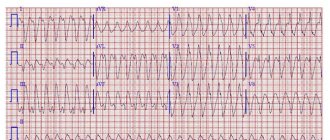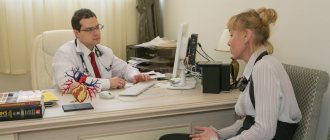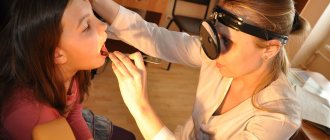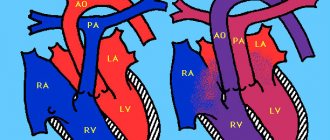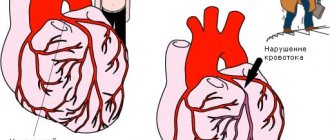When visiting a doctor, some patients complain that after eating they experience rapid heartbeat or a feeling of their heart jumping out of their chest. All these are symptoms of arrhythmia, but can it really occur after eating and if so, what are the causes of this pathological condition?
Arrhythmia is well known among a wide range of cardiac patients. It does not bother many people at all; in other cases it manifests itself as severe attacks of rhythm disturbance. But one of the variants of the course of the disease is the appearance of palpitations after eating. This does not happen very often, but requires utmost attention to prevent more severe illnesses.
The occurrence of arrhythmia after eating is typical for older people, women with a labile psyche, abusing alcoholic beverages and patients with poor nutrition.
Using modern diagnostic methods, the form of arrhythmia is determined quite quickly. First of all, electrocardiography is performed. If there are any doubts about the final diagnosis, other diagnostic methods are used: Holter monitoring, electrophysiological study, cardiac ultrasound, etc.
Video Live great! Frequent heartbeat. How to calm your heart
Why does eating food cause arrhythmia?
Gastrocardiac syndrome - this is the medical term for a condition that is expressed in irritation of the cardiac part of the stomach, which subsequently causes arrhythmia, heart pain, and angina attacks. As a result, the patient develops severe anxiety and a serious illness affecting the heart. In fact, everything is not so scary if you follow your doctor’s recommendations.
Mechanisms of arrhythmia after eating:
- Eating plenty of food provokes blood flow to the digestive organs, including the stomach.
- The enhanced digestion process causes increased activity of the fibers of the parasympathetic system, in particular the vagus nerve.
- Under the influence of the vagus nerve, the heart rate changes, which, as a rule, slows down.
In some cases, instead of bradycardia, patients, on the contrary, feel a rapid heartbeat or extrasystole. This is due to the fact that the activity of the parasympathetic innervation decreases over time and the sympathetic nervous system begins to replace it. This leads to a sudden increase in heart rate, which usually occurs in the afternoon. Therefore, having eaten well, such patients, instead of relaxing, begin to tense up due to the rhythm disturbance that has arisen.
Intestinal arrhythmia is one of the most common conditions of a modern person who considers himself healthy, and it occurs long before he can become a patient. This arrhythmia is typical not only for patients with internal diseases, but also for 50-80% of the population who are in the so-called “third state” - between health and an as yet unconscious disease. Intestinal arrhythmia is a violation of the regularity of the circadian rhythm of the intestinal evacuation function when the frequency of this rhythm deviates from the physiological one.
Normally, during daily nutrition, the frequency of intestinal evacuation function should not deviate from the regular circadian rhythm with a period of 20-28 hours. The normal frequency of cleansing the body of substances harmful to its health should be at least 7 times a week. From the standpoint of chronomedicine, what is adequate for a healthy person is the daily rhythm of removing harmful metabolites from the body. With intestinal arrhythmia, when the regularity of elimination of toxic substances from the intestines is disrupted, the likelihood of disease increases significantly.
The need to eliminate intestinal arrhythmia has three main aspects.
- Firstly, eliminating irregularities in bowel function can help prevent internal diseases, since intestinal arrhythmia is one of the “universal pathogenic blocks.”
- Secondly, eliminating the irregularity of the body’s self-cleansing of carcinogenic metabolites can serve to prevent cancer, since intestinal arrhythmia is a proven risk factor for colorectal cancer, pancreatic cancer and gall bladder cancer.
- Third, eliminating intestinal arrhythmia is necessary to improve health-related quality of life both in people who “consider themselves healthy” and in seriously ill patients.
Intestinal ari
Intestinal ari, as was previously believed, and “the initiator of internal diseases,” as is currently believed.
Intestinal arrhythmia, as a functional disorder, usually precedes the onset of organic changes; it occurs already in the first year of life, long before the onset of most internal diseases. The universal nature of intestinal arrhythmia is evident from the fact that its late stages are detected in more than 60% of patients with hypertension, in almost 70% of patients with varicose veins and in 50-80% of patients with gastric and duodenal ulcers.
Therefore, timely elimination of intestinal arrhythmia can help prevent many diseases and improve the quality of health. Elimination of intestinal arrhythmia in terms of cancer prevention is due to the fact that it can lead to a decrease in the concentration of carcinogenic metabolites and reduce the duration of their action on the intestinal mucosa. The health-related quality of life of pregnant women in the absence of intestinal arrhythmia was almost 20% higher than in the presence of this arrhythmia.
Modern approaches to eliminating intestinal arrhythmia
Modern approaches to eliminating intestinal arrhythmia take into account the multifactorial nature of its origin and are multifaceted. First of all, the doctor explains to the patient the rhythmic essence of intestinal activity, pointing out that the circadian rhythm of the gastrointestinal tract is its attributive property. Medicines that themselves are inducers of constipation are discontinued: analgesics, antidepressants, calcium antagonists and others.
For intestinal arrhythmia, you should not prescribe widely used laxatives, which are not so much helpful as harmful to health.
- Senna extracts containing anthraquinones damage colonic neurons and increase the permeability of the intestinal barrier, promoting allergic reactions.
- Phenolphthalein turned out to be a carcinogen, so it has been officially banned in the United States since 1999.
- Bisacodyl can cause urolithiasis.
- Sodium picosulfate can lead to fatty degeneration and necrosis. Saline laxatives cause disruption of water-electrolyte metabolism in the form of hypokalemia, which is dangerous for the heart.
- Synthetic prokinetics can cause galactorrhea and gynecomastia.
To eliminate intestinal arrhythmia it is necessary.
To eliminate intestinal arrhythmia, it is necessary to take an adequate amount of fluid (1.5-2 liters per day) in the form of juices, fermented milk products and mineral water.
Wholemeal bread and about 500 g of vegetables and fruits per day are recommended. Be sure to take into account the essential role of regular physical activity for daily bowel function.
When prescribing medications that eliminate intestinal arrhythmia, it is necessary to choose only safe and highly effective drugs.
These currently include macrogol 4000 and mucofalk. These medications are not absorbed in the intestine and help retain sufficient fluid in the colon. They form a comfortable stool and do not have side effects that are dangerous for the patient.
- Macrogol 4000 (Forlax, Bofur Ipsen) is effective when taken as a course and is not addictive.
- Forlax helps to delicately solve a delicate problem even in pregnant women, diabetics and hypertensive patients.
- Mucofalk(r) by swelling and binding water in the intestine accelerates the movement of contents through the intestines and increases the volume of stool.
By regulating passage through the intestines, mucofalk reduces the spastic state of the colon, which leads to the elimination of intestinal arrhythmia and the restoration of regularity in bowel function. It is extremely important that the elimination of intestinal arrhythmia with mucofalk in patients with hypercholesterolemia leads to a decrease in the level of cholesterol and low-density lipoproteins in the blood serum by 15-20%.
K. A. Shemerovsky, leading researcher at the Research Institute of Experimental Medicine, St. Petersburg
Symptoms of arrhythmia developing after eating
All arrhythmias are manifested by disturbances in heart rhythm, the appearance of “dips” in the heartbeat, and deterioration in general well-being. But with arrhythmia that occurs after eating, more specific signs are observed that are not found in other cases.
- Sometimes it may feel like your heart has stopped.
- Discomfortable sensations in the heart area, often manifested by pain and its spread along the left arm.
- Consciousness may be “lost” for a short time.
- Feeling of nausea and fullness in the stomach.
- The sweat glands begin to act more actively.
- There is a feeling of weakness throughout the body.
- Periodic dizziness.
- Body temperature rises.
- My mouth often gets dry.
Arrhythmia after eating has become particularly popular recently, since many people eat excessively and exercise little. Obesity, which is an endocrinological disorder, plays a particularly important role in the development of pathology. Therefore, rhythm disturbances are not always observed in cardiac patients. There are also other risk factors that, if present, increase the likelihood of developing pathology.
Treatment of arrhythmia
Often, when a doctor prescribes a small dose of medication and with lifestyle corrections - quitting smoking, alcohol, intense physical and emotional stress - the arrhythmia gradually goes away.
For the treatment of pronounced arrhythmias, as well as severe conditions, a pacemaker is used. This is a device that replaces the work of the heart. Using electrical impulses, it tells the heart to beat at the correct frequency and intensity. This device is implanted under the patient's skin in the chest area. Special electrodes that are directed to the heart through the vessels and impart an electrical impulse to it. Thanks to modern technological developments in the field of medicine, the batteries that support the operation of the device can last from 8 to 10 years. The device is designed so that neither extraneous microwaves, nor electrical devices, nor radars and other equipment interfere with the operation of the pacemaker. The only exceptions are magnetic resonance imaging devices and other devices intended for physical treatment.
Pacemakers are used mainly in cases where, as a result of arrhythmia, the heart makes a small number of contractions. Then the stimulator normalizes the rhythm and brings the number of contractions to normal. In the opposite case, when the arrhythmia is accompanied by too intense heartbeat, the stimulator is used very rarely.
In some serious cases, arrhythmia requires surgery. If the arrhythmia is caused by coronary heart disease, then in this case an operation called balloon angioplasty or coronary artery bypass grafting is performed. Sometimes arrhythmia is caused by a malfunction of the electrical center in the heart. It is eliminated by catheter ablation, when a catheter is inserted into the heart and a series of radiofrequency current discharges are applied through it.
Arrhythmia that occurs after a heart attack is treated with open-heart surgery, which removes the damaged muscle that is interfering with the normal functioning of the heart.
Risk factors
Arrhythmia after eating does not in itself pose a danger to human health or life. But sometimes the disease develops against the background of organic heart damage, which can worsen the course of the disease. Therefore, when determining rhythm disturbances after eating, you should not relax, but first of all you need to reconsider your lifestyle and check whether certain risk factors are identified.
- Alcohol abuse is in the first place, since many modern people cannot imagine a holiday without drinking. In fact, alcohol easily and quickly stimulates the heart, but with frequent exposure, the conduction system of the heart stops generating electrical impulses normally. After eating, the heart, as described above, experiences a load, so in severe cases it even stops coping with it, resulting in arrhythmia.
- Frequent meals - this refers to meals, not normal meals. During a meal, a lot of things are eaten, even without normal chewing. The abundance of food is accompanied by a large number of different drinks. All this has an extremely negative effect on cardiovascular activity, as well as on other organs and systems, so it is not surprising that arrhythmia occurs from overload.
- Stressful situations worry almost every person today. Only if you have certain skills can you not react to many irritating factors. The heart is extremely sensitive to any experiences and worries, so excessive emotionality can also aggravate the course of arrhythmia that occurs after eating.
- Undergoing rehabilitation after a serious illness - this factor is almost impossible to eliminate, but if desired, its influence can be minimized. In particular, various practices aimed at improving the health and general well-being of the patient help.
Arrhythmia after eating may be the first sign of a more complex disease, so it is very important, after identifying it, to consult a doctor so that appropriate treatment measures can be prescribed.
Video Five things you shouldn't do immediately after eating!
Causes of arrhythmia
The main and most common causes are alcohol abuse, smoking, physical and emotional stress, stress and depression. The quality of heart contractions can be affected by the pathological condition of the thyroid gland; some medications have the effect of arrhythmia. These are, for example, drugs for normalizing high blood pressure and treating lungs. Arrhythmia is often a consequence of severe heart pathology, so first of all it is necessary to treat the underlying ailment that caused it. These are such severe pathologies as ischemic disease, abnormalities in the condition of the heart valves, and manifestations of heart failure. Sometimes arrhythmias appear out of the blue without a specific reason.
Methods of influence
First of all, you should pay attention to your diet. In this case, the patient is recommended to adhere to certain rules:
- You need to take food only in small portions to avoid overloading the stomach, leading to stimulation of the vagus nerve and the occurrence of arrhythmia.
- Eating should be done in a calm environment, and each portion of food should be chewed thoroughly.
- If you are overweight, you should regularly
- o carry out fasting days, which can be based on fruit, kefir, and cottage cheese diets.
- You need to take liquid in small quantities, even if you are very thirsty. The temperature of both food and drinks should not exceed 36-37 degrees.
- After dinner or lunch, you should not take a horizontal position to rest. It’s smarter and healthier for the body to take a walk in the fresh air for two to three hours and only then get ready for a night’s sleep.
A short question and answer on arrhythmia after eating
Can arrhythmia that occurs after eating pose a danger? In most cases, no, but in the presence of organic heart pathology, drug treatment should be carried out.
In what cases should you be wary? You should go to a doctor immediately if one of the symptoms is detected: shortness of breath, prolonged dizziness, frequent loss of consciousness, severe weakness, increased anxiety, extremely unpleasant sensations in the heart area.
Who is at risk for arrhythmia that occurs after eating? First of all, elderly people, as well as pregnant women, professional athletes, obese patients and those undergoing rehabilitation after a long illness.
4.33 Aug. rating ( 86 % score) - 21 votes - ratings
Diagnosis of the disease
In diagnosing any type of arrhythmia, it is important to describe the symptoms and sensations as accurately as possible. The doctor needs to know the heart rate, whether it is low or high, how often this condition occurs, how long the attack lasts, whether it is accompanied by dizziness, headaches, whether there were fainting, chest pain, shortness of breath and other strange sensations.
In addition, the doctor needs to tell in what situations these sensations occur: at rest or during physical activity. As the painful process occurs, it begins with sharp pain or its intensity gradually increases. To more accurately determine the patient's condition, various clinical studies are conducted. The main way to detect abnormalities in heart rhythm is a cardiogram. This study makes it possible to obtain a graphical diagram that displays the frequency and intensity of the heartbeat.
Holter monitoring makes a more thorough study of heart rhythm, which can be done in our clinic. The patient carries the monitor with him throughout the day. The device records heart rate at every moment of time. In addition to this, the subject keeps regular records of his actions and feelings. This method allows you to identify serious abnormalities and their frequency more accurately.
If the arrhythmia can be life-threatening, and the patient’s condition is quite serious, then a heartbeat study is carried out while the person is hospitalized. In these cases, an electrophysiological study is performed. Here a special probe is used, inserted through a vein directly into the heart. To accurately diagnose the patient's standing, various stimulants and special methods of monitoring cardiac activity are used.

